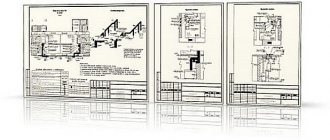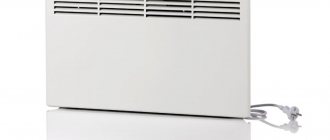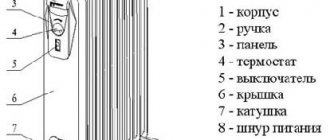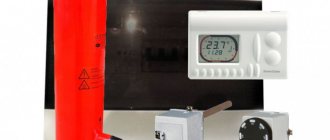Here you will learn:
- What determines the actual power consumption?
- The procedure for calculating the power of an electric boiler
- Initial data
- Calculate energy consumption by power
- Calculation of consumption based on housing characteristics
- How to reduce electrical energy costs
Electric boilers are distinguished by four main characteristics:
- Power. Electricity consumption depends on it.
- Device. An electric boiler can heat the coolant in different ways: heating elements (efficiency up to 95%), induction heating (efficiency up to 98%), electrode (efficiency up to 98%).
- Number of circuits – 1 or 2.
- Construction (boiler room or not).
The choice depends on your requirements and preferences; double-circuit boilers will provide you not only with heating, but also with hot water. Boiler rooms are more economical, with heating elements they are easy to repair, and with electrodes they are more efficient.
What determines the actual power consumption?
The most significant power consumption of an electric heating boiler depends on:
- Operating conditions. Namely, on the desired temperature regime (a decrease in temperature by 1°C implies up to 5% savings), constancy of residence in the house and regulation of indicators during sleep or absence of the owners of the house.
- Technical condition of the boiler. Namely, its heating elements (tubular electric heaters). When using hard, untreated and constantly replaced water as a coolant, scale forms on heating elements, which reduces efficiency from 99% to 90.80 and even 70%. To heat the coolant to the previous temperature through a layer of scale, the electric boiler requires more energy and time.
- Equipment. The circulation pump and advanced automation consume from 60 to 150 W. However, these are not so significant values against the background of already expensive operating costs.
- Automation functionality. Advanced modern automation has several operating modes, more competently controls the switching on and off of heating elements, the operation of the circulation pump, smoothly regulates the temperature, and allows you to set hysteresis values. Electric boilers in the middle and higher price categories are often equipped with the ability to program the operating mode, which significantly affects consumption.
How to save money
Installing a two-tariff meter allows you to save on heating costs with electricity. Moscow tariffs for apartments and houses equipped with stationary electric heating systems distinguish between two prices:
- 4.65 RUR from 7:00 to 23:00.
- 1.26 rubles from 23:00 to 7:00.
Then you will spend, subject to round-the-clock operation of a 9 kW electric boiler turned on at one third of the power:
9*0.3*12*4.65 + 9*0.3*12*1.26 = 150 + 40 = 190 rubles
The difference in daily consumption is 80 rubles. You will save 2400 rubles per month. Which justifies the installation of a two-tariff meter.
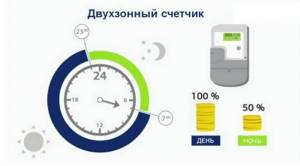
The second way to save when using a two-tariff meter is to use automatic control devices for electrical appliances. The idea is to place the peak consumption of an electric boiler, boiler, etc. at night, then most of the electricity will be charged at 1.26, not 4.65. While you are at work, the boiler can either turn off completely or operate in a reduced energy consumption mode, for example at 10% of power. To automate the operation of an electric boiler, you can use programmable digital thermostats or boilers with programming capabilities.
In conclusion, I would like to note that heating a house with electricity is quite an expensive method, regardless of the specific method, be it an electric boiler, convector or other electric heater. People come to him only in cases where there is no way to connect to gas. In addition to the costs of operating an electric boiler, you will also face the initial costs of arranging for a three-phase electricity supply.
The main troubles are:
- preparation of a package of documents, including technical specifications, electrical design, etc.;
- organization of grounding;
- the cost of cable for connecting the house and installing new wiring;
- installation of the meter.
Moreover, you may be denied three-phase input and an increase in power if there is no such technical possibility in your area, when transformer stations are already operating at the limit. The choice of boiler and heating type depends not only on your desires, but also on the capabilities of the infrastructure.
This is where we end our short article. We hope you now understand what the real electricity consumption of an electric boiler is and how you can reduce the cost of heating your home with electricity.
It is impossible to determine the exact consumption of an electric boiler, since it depends both on weather conditions, the location and parameters of the house, as well as on operating conditions and the functionality of the automation. However, calculating an approximate figure and presenting the approximate amount to pay for heating a private house with an electric boiler is quite simple. At the same time, not everyone knows that energy consumption can be reduced by 10, 30, and sometimes even 50% by resorting to small, quickly recouping costs, which are described in detail in this article.
Read in the article
Initial data
First, a few general notes to help you understand the proposed schemes:
- Part of the time the boiler is idle or operates at reduced power. Its rated power is selected to match the peak energy consumption of the house, which occurs on the coldest days of winter. When the thermometer rises, the need for heat decreases;

During the thaw, the home's need for heat decreases.
Thermal energy consumption, with constant thermal conductivity of the walls, is directly proportional to the temperature difference between the house and the street. It will decrease not only when the outside temperature increases, but also when the internal temperature decreases.
- The efficiency (coefficient of performance) of any electric heating device with a minimum error is 100% and does not depend on the type of heating element. The small amount of heat that is dissipated by the body of the device also goes to heating the house;
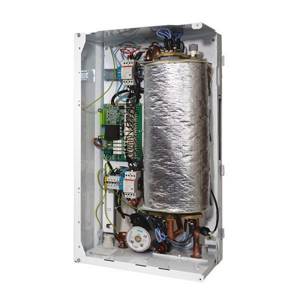
To reduce non-target heat losses, the boiler heat exchanger is insulated with mineral wool or teplovol (foil insulation based on heat-resistant foamed polymer).
Therefore, the thermal power of a boiler is always taken equal to its electrical power: a device that consumes 8 kilowatts of electricity will give off the same amount of heat.
- The average actual consumption of a boiler with correctly calculated power is approximately equal to half the consumption at rated power for the same time. Simply put, an 8-kilowatt appliance consumes 4 kilowatts on average during the winter months.
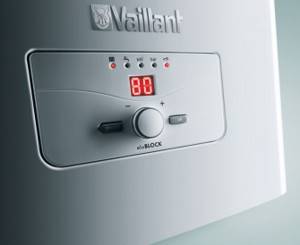
Having heated the water to the desired temperature, the boiler turns off the heating and waits for the coolant to cool.
How to reduce electrical energy costs
Now you have found out how many kilowatts an electric boiler consumes and, perhaps, have made your calculations. It will be useful to learn about methods and techniques for reducing energy consumption at the calculation stage:
- Improving the work on temperature changes allows you to avoid temperature fluctuations in rooms with different purposes and reduces energy consumption. For this they are used. They allow the owner to reduce or increase the heating power at any time. The amount of energy consumed depends largely on the temperature outside. Naturally, the lower the air temperature outside the window, the greater the consumption.
- The results of calculating consumption and cost are influenced by the type of accounting and the use of a mixed heating method. It is clear that the daily distribution of loads between energy consumers is different. As a result, in order to maintain the required temperature, it is logical for the boiler to operate at night (from 23.00 to 6.00), that is, when energy consumption begins at a minimum and at other rates.
Multi-tariff accounting makes it possible to save about a third of financial costs.
It is possible to achieve better performance in the operation of the boiler by using pressure circulation equipment. The pump is mounted in the return network and minimally limits the period of contact of the walls of the heating unit with the hot coolant. Therefore, the use of the generated heat source becomes longer.
You can save money on electricity costs by adding a device for obtaining heat from other raw materials to a functioning boiler. In addition, this will reduce the consumption of gas, fuel oil, coal or other selected energy source.
Therefore, the energy consumption of the boiler can be optimized. But you need to put effort into this.
Calculate energy consumption by power
If the average power of the boiler is known, it is not a problem to calculate how much the device consumes per month and over the entire winter.
Example
Let's find out, as an example, how much energy is needed for a boiler with a rated power of 12 kilowatts:
- Its average power is 12/2=6 kW;
- Consumption per day - 6*24=96 kilowatt-hours;
- Heating will consume 96*30=2880 kWh per month;
- Electricity consumption during the winter with a heating season of 180 days (from October 15 to April 15) will be 180*96=17280 kWh.
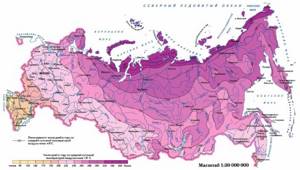
The length of the heating season in your region can be found on this map. The heating turns on when the air temperature drops below +8 and turns off when the temperature rises above +8.
Now let's do one more calculation - find out how much heating will cost. I use data for a single-rate tariff in Sevastopol as of January 2021:
- When consuming up to 150 kWh per month, a social tariff of 2.42 rubles applies;
- In the range of 150 - 600 kilowatt-hours per month, the price increases to 2.96 rubles;
- Electricity above 600 kWh per month costs pennies.
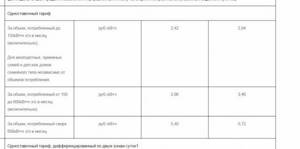
Current electricity tariffs. Sevastopol, first half of 2021.
Of the monthly 2880 kWh, 150 will be at a reduced tariff and will cost 150 * 2.42 = 363 rubles. The next 450 kWh are paid at 2.96: 450*2.96=1332. The balance is 2880-600 = 2280 kWh for 5.40 rubles, or 12312 rubles.
Total 12312+1332+363=14007 rubles.
When using a single-tariff meter, electric heating will cost a pretty penny.
If you have a gas boiler of the same power installed, heating costs under the same conditions will be approximately 1,500 rubles. Electric heating is the most expensive way to heat a home.
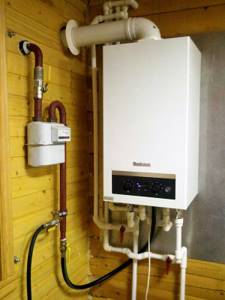
Switching to mains gas will greatly reduce your home heating costs.
Factors that reduce energy consumption
As already mentioned, when installing electric heated floors in all rooms of the apartment, the payment costs will be impressive, which will affect your family budget.
However, there are ways to reduce energy consumption:
- Carrying out high-quality insulation - good thermal insulation reduces consumption by 35 - 40%.
- Installing a multifunctional meter - the cost of electricity used at night is about 2 times lower. Moreover, heating mainly works when there are people in the house, and this is usually in the evening and night.
- Installation of heated floors should be carried out in a free area. Laying it under furniture is not only unprofitable, but also prohibited by the system manufacturer.
- Use of finishing coatings with a good degree of thermal conductivity.
- Installing a programmable thermostat, especially in residential areas, will allow you to save a third on energy.
- In sparsely inhabited rooms, not maintaining a high degree of heating is an unnecessary waste of energy.
Climatic conditions are also of great importance. The greater the difference between the temperature in the room and outside the window, the power consumption of electricity increases.
Thermostat is an indispensable device for reducing costs
Separately, it should be said about the thermostat - its use can reduce energy consumption by up to 40%. It is recommended to install the device in the coldest place in the room. When the temperature drops below the set value, it will turn on the heating, and when the desired value is reached, it will turn off.
In many ways, electricity consumption is influenced by the type of thermostat, they are:
- mechanical - the design is simple and inexpensive, the daily working time is about 12 hours;
- programmable - equipped with several modes that allow you to control operation; such a device operates only 6 hours a day.
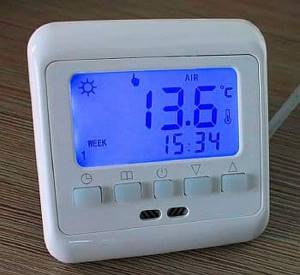
Using an example, we will consider which type of thermostat will be more economical. To do this we use the formula:
Рд = t * Ptot;
t—device operating time;
Ptot—power.
When installing a mat with a voltage of 900 W, and using a mechanical type regulator:
Pd = t * Ptot = 12 h * 900 W = 10,800 W = 10.8 kW
If a software controller is installed, then:
Pd= t * Ptot = 6 h * 900 W = 5,400 W = 5.4 kW
From this calculation it is clear that the use of a programmable controller will significantly reduce your costs.
If the warm floor acts as the main heating in all rooms, then the installation of several regulators will be required, which are connected to one centralized system.
When thinking about installing an electric floor in a house or apartment, you should make all the required calculations, taking into account the maximum load in winter. Only after weighing all the pros and cons, you need to make a decision about installing such a structure.
Calculation of consumption based on housing characteristics
An electric boiler does not always exactly match the heating energy needs of a home. Often its power is selected with a reserve. Here are some examples of such scenarios:
- A dual-circuit device provides the house with hot water;
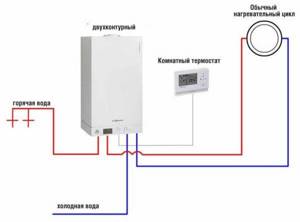
The power of a double-circuit boiler is excessive, since it must provide the house with hot water. Including during the heating season.
- It is planned to add additional rooms to the house with the connection of heating devices in them to the existing circuit;
- The region is characterized by rare but severe frosts, and the heating system is designed specifically for them.
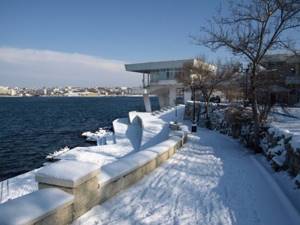
If the boiler power is obviously excessive, you will have to focus not on it, but on the actual heat consumption of the house. Most accurately, it can be calculated using the formula Q=V*Dt*k/860.
The variables in this formula from left to right are:
- Energy consumption (kW);
- The volume of the room that needs to be heated. It is indicated in SI units - cubic meters;

The volume of a room is equal to the product of its three dimensions.
- Difference between indoor and outdoor temperatures;
- Insulation coefficient.
Where do I get the last two parameters?
The temperature delta is taken equal to the difference between the sanitary norm for the room and the coldest five days of winter.
You can take sanitary standards for residential premises from this table:
| Description | Temperature norm, C |
| A room in the center of the house, the lowest winter temperature is above -31C | 18 |
| A room in the center of the house, the lowest winter temperature is below -31C | 20 |
| Corner or end room, lower winter temperature above -31C | 20 |
| Corner or end room, lower winter temperature below -31C | 22 |
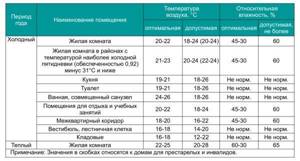
Sanitary temperature standards for non-residential rooms and common areas.
And here is the temperature of the coldest five-day period for some cities of our great and vast:
| City | Value, C |
| Khabarovsk | -29 |
| Surgut | -43 |
| Smolensk | -25 |
| Saint Petersburg | -24 |
| Saratov | -25 |
| Petrozavodsk | -28 |
| Permian | -25 |
| Eagle | -25 |
| Omsk | -37 |
| Novosibirsk | -37 |
| Murmansk | -30 |
| Moscow | -25 |
| Magadan | -29 |
| Kemerovo | -39 |
| Kazan | -31 |
| Irkutsk | -33 |
| Ekaterinburg | -32 |
| Volgograd | -22 |
| Vladivostok | -23 |
| Vladimir | -28 |
| Verkhoyansk | -58 |
| Bryansk | -24 |
| Barnaul | -36 |
| Astrakhan | -21 |
| Arkhangelsk | -33 |
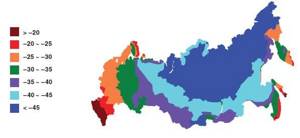
Distribution of winter temperatures across Russia.
The insulation coefficient can be selected from the following range of values:
- A house with an insulated facade and triple glazing - 0.6-0.9;
- Two-brick walls without insulation and double-glazed windows - 1-1.9;
- Brick walls and single-strand glazed windows - 2 - 2.9.
Example
Let's calculate the electricity consumption for heating with our own hands for a month for the following conditions:
House size: 6x8x3 meters.
Climatic zone: Sevastopol, Crimea peninsula (the temperature of the coldest five-day period is -11C).
Insulation: single glass with high thermal conductivity, walls made of rubble stone half a meter thick.

A rubble house with single glazing requires intense heating in winter.
| We calculate the volume. 8*6*3=144 m3. |
| We calculate the temperature difference. The sanitary standard for a private house (warm region, all rooms are at the end or corner) is 20C, the temperature of the coldest five days of winter is -11. Delta - 20 - -11 = 33C. |
| We select the insulation coefficient. Thick walls made of rubble stone with its high thermal conductivity and single glazing give its value around 2.0. |
| Substitute the values into the formula. Q=144*33*2/860=11 (rounded) kilowatt. |
We have calculated the maximum heat demand that the rated power of the electric boiler must correspond to. We are already familiar with the instructions for calculating its actual average consumption: the resulting value must be divided by 2. 11/2 = 5.5 kW.
We also went through the technique of further calculations:
- The boiler will consume an average of 5.5*24=132 kWh per day;
- It will consume 132*30=3960 kilowatt-hours of electricity per month.
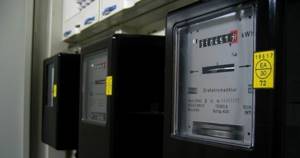
Switching to a two-tariff meter will allow you to slightly reduce heating costs.
How to calculate how much you need to pay for electricity
To calculate the cost of electricity you consumed last month, you need to:
- Every month on the same day (for example, the 25th), record the electricity meter readings. For example, on January 25th the readings were equal to 5500.1 kWh, and on February 25th - 5750.6;
- subtract the previous one from the last reading. In our example: 5750.6 - 5500.1 = 250.5 kWh. How much electricity have you consumed in a month?
- You need to transfer to the supplying companies the numbers that you rewrite every month (5500.1 for January, 5750.6 for February).
Read about how to save on electricity bills in an apartment or private house.
How much electricity does a kettle consume?
An electric kettle is a convenient household appliance that can provide its owners with boiling water in a matter of minutes.
It is necessary to calculate how many kilowatts a kettle consumes, taking into account the power of the device and the maximum volume of liquid that it can bring to a boil. The larger the displacement of the device, the more time it will take to heat the water, and accordingly the amount of electricity consumed increases. On the other hand, the high power of the kettle contributes to its fast operation. However, it requires a sufficient amount of electricity.
All electric kettles are different in their parameters and, accordingly, in their level of energy consumption.
To calculate how much a kettle consumes, you should perform the following calculations:
- The power of the device is taken from the passport;
- the time it takes to boil water in the kettle is calculated;
- electricity consumption per unit time is determined;
- the resulting value should be multiplied by the number of times the water is boiled;
- monthly electricity consumption is determined.
Based on the table, the power of the electrical appliance is in the range of 700-3000 W, which depends on the volume of the bowl, body material, displacement, type of heating element, and chemical composition of the water. The heating element can be open (spiral) or closed (plate) type. The first option provides a high rate of water heating and, accordingly, uses less energy.
The energy consumption of the device is also influenced by the housing material. In a metal bowl, water heats up faster. However, an additional amount of electricity is spent on heating the case. Glass also heats up quickly, but retains heat less well. Ceramic has a slow heating rate, but the water in the kettle will remain hot for a long time.
Note! Boiling water in an electric kettle is less expensive than using an electric stove. If you pour a minimum amount of water into the kettle without reserve, you can reduce the waste of both water and electricity. To reduce the kettle's energy consumption, unplug the appliance from the outlet when not in use.
The required volume of water should be poured into it, without reserve. You should monitor the condition of the heating element by regularly descaling it
To reduce the kettle's energy consumption, unplug the appliance from the outlet when not in use. The required volume of water should be poured into it, without reserve. You should monitor the condition of the heating element by regularly descaling it.
Some details in examples
It is also necessary to take into account the cable cross-section, especially if high-power electric boilers are connected. The cut area of current-carrying conductors for single-phase units is determined by an elementary formula, which is perceived as an axiom. Section in sq. mm must be no less than the rated power, which characterizes the performance and consumption of the electric boiler and expressed in kW
With three-phase power supply, the calculation is more complicated and it is important not to forget that electricity consumption by an electric boiler over 10 kW requires registration of permits for the selection of this load from the electrical network
Which brand of electric heating boiler is better?
Good inexpensive electric boiler RusNIT 209M
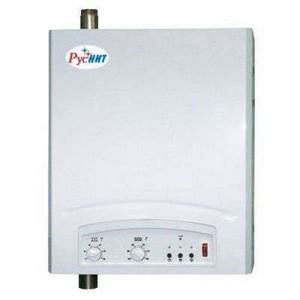
Photo: www.teplosila.ru
Rating: 9.9 out of 10.
Average price: RUB 16,279
A compact, lightweight, domestically produced electric boiler can be called the best among inexpensive ones. The total power of the boiler is small, 9 kW, but this is enough to heat rooms with a total area of 70-90 m2 (living area of a medium-sized house or cottage, country house). At the same time, the quality and range of functions are no worse than those of expensive imported models: the work is fully automated, you can configure all the main indicators (power in three stages, air temperature, coolant temperature).
From reviews of the electric boiler RusNIT 209M:
“I’ve had an electric RusNIT in my dacha for 2 years now. Never let me down yet. The house still warms up perfectly. The good thing about it is that when you turn it on, it doesn’t immediately load the system; it distributes the load evenly across each phase. This means that, including other devices, you don’t have to worry about them burning out.
It is only important that the boiler is installed by specialists, and maintenance must be carried out on time.”
- low price
- easy installation
- smooth power adjustment
- precise temperature adjustment (+/- 0.5 °C)
- air heating within 5-30 °C
- overheat protection
- coolant presence sensor
- The housing is splash resistant.
Disadvantages of the model:
not suitable for a large house.
The best electric mini-boiler EVAN Warmos QX-18
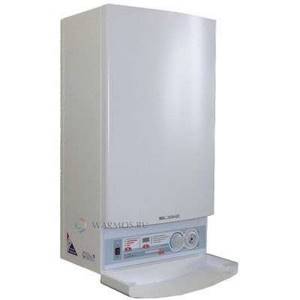
Photo: warmos.ru
Rating: 9.8 out of 10.
Average price: 31,400 rub.
The best among powerful Russian-made electric boilers. It can safely be called a mini-boiler room: heating elements (material - stainless steel), a membrane expansion tank, and a circulation pump are assembled in one housing - all this allows you to save space during installation and reduce time. The LCD display is located at the bottom of the case. The convenient control panel is hidden behind a special door. The operation is regulated by a microprocessor, the control is fully automatic, but you can switch the device to manual mode and adjust all the parameters to your taste and needs. It works stably even with voltage fluctuations, but it is still better to connect the boiler through a stabilizer. Versatile. Suitable for heating residential premises (houses, apartments) and industrial facilities (warehouses, shops, etc.)
From reviews of the electric boiler EVAN Warmos QX-18:
“I bought Varmos and installed it at the dacha parallel to the old solid fuel one. Installation is elementary. It has been working for 5 years, no problems"
- works quietly
- built-in expansion tank 12 l
- 3 stages of power adjustment
- microprocessor control
- smooth power adjustment
- control panel at the bottom of the case
- thermostat (air temperature adjustment for 7 days)
- manual adjustment mode available
- built-in pump
- overheat protection, short circuit protection
- coolant level sensor
- pressure meter
- indication of emergency condition (light, sound).
Disadvantages of the model:
- bulky and heavy
- weak point - capacitor
- It is necessary to install a voltage stabilizer
When choosing heating equipment today, it is easy to get confused, since there is a very wide selection of models on the market. There are both simple boilers for apartments and more complex equipment designed for installation in a large country house or country house. They all differ in power, additional features, and connection technologies.
In order not to make a mistake with your choice, you need to pay attention to the rating, which clearly demonstrates which equipment is optimal in certain conditions

To choose the right boiler, you need to pay attention to the rating, which demonstrates all the advantages or disadvantages of the equipment. Choosing a gas boiler will be much easier if you know exactly what functions are needed, what estimated power can satisfy all the needs for heating and hot water supply
The rating will help you understand all the intricacies of such installations
Choosing a gas boiler will be much easier if you know exactly what functions are needed, what estimated power can satisfy all the needs for heating and hot water supply. The rating will help you understand all the intricacies of such installations.



